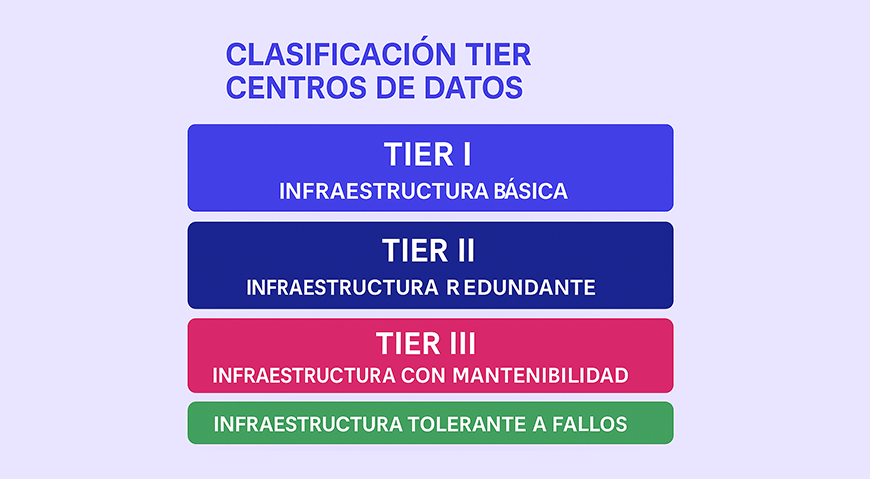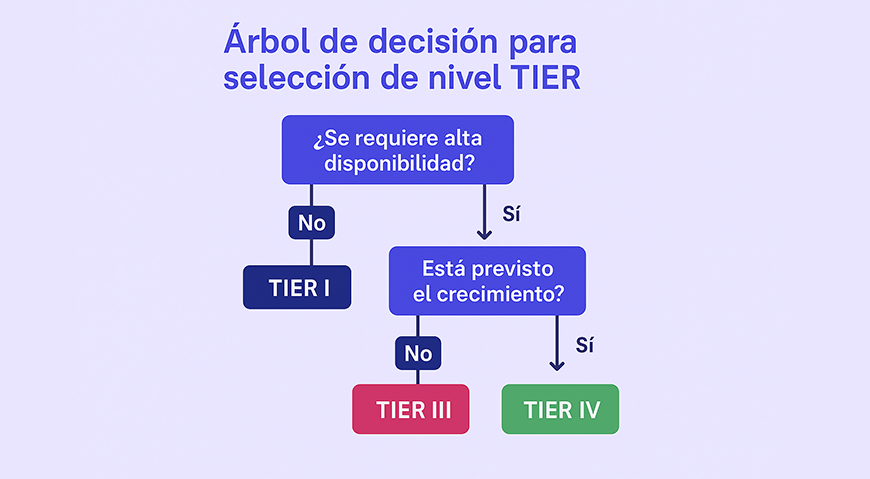Introduction to TIER Classification
Imagine you need to choose a vehicle to transport a valuable shipment. You could select
from a basic motorcycle to an armored truck with multiple security systems. The choice
would depend on the value of the cargo and the consequences of losing it. Similarly, when we talk about
data centers, the TIER classification provides us with a standardized framework to evaluate their
reliability and availability.
The TIER classification was developed by the Uptime Institute—the world's leading organization in
certification and consulting for critical infrastructure—as an objective method to evaluate the
performance, investment, and return offered by different data center infrastructures in
terms of service availability.
As the Uptime Institute itself describes:
"The TIER Classification system evaluates the potential performance of a site's installed infrastructure
in terms of uptime. It defines the requirements and benefits of four
classifications of data center infrastructure topologies, and establishes criteria to
differentiate the ability of these infrastructures to maintain site availability."
This classification system, which has become the de facto standard worldwide, establishes
four progressive levels (TIER I, II, III, and IV) that describe the robustness of the physical infrastructure
of the data center and, consequently, its ability to maintain operations in the face of various
disruptive events, from equipment failures to major catastrophes.

Detailed TIER Levels: From I to IV
Each TIER level represents a significant leap in terms of redundancy, fault tolerance, and
ability to perform maintenance without interruptions. Let's look at each one in detail:
TIER I: Basic Infrastructure
The most basic level of the classification provides a dedicated infrastructure for IT systems,
separate from office spaces, but with limited resistance to disruptive events.
Key features:
- No redundancy in critical components
- A single path for power and cooling distribution
- Susceptible to interruptions from planned and unplanned events
- Typical annual availability of 99.671% (equivalent to about 29 hours of downtime per year)
- Requires complete shutdown for maintenance
- Has a backup generator, but no guarantee of functioning in case of failure
Use cases: Small businesses with basic technological needs, environments where
a few hours of annual downtime do not represent a critical impact, or as a complement to
main operations hosted in higher-level facilities.
TIER II: Redundant Components
This level introduces the fundamental concept of partial redundancy, significantly improving
availability compared to TIER I.
Key features:
- Basic redundancy in critical components (N+1)
- A single path for distribution, but with redundant elements
- UPS and generators with N+1 capacity
- Cooling systems with some redundancy
- Typical annual availability of 99.741% (approximately 22 hours of downtime per year)
- Still vulnerable to interruptions during planned maintenance
Use cases: Medium-sized businesses where technology is important but not critical to
minute-to-minute operation, educational institutions, local governments, and organizations with
tighter budgets that need a good level of reliability.
TIER III: Concurrent Maintainability
The jump to TIER III represents a fundamental change in design philosophy, introducing the
critical ability to perform maintenance without stopping operations.
Key features:
- Multiple paths for power and cooling distribution, but only one active
- All components are concurrently maintainable (can be serviced without
service interruption)
- N+1 redundancy in all critical systems
- No single points of failure that cause interruption
- Typical annual availability of 99.982% (less than 1.6 hours of downtime per year)
- Maintenance does not require equipment shutdown
- Still vulnerable to some critical events or human errors
Use cases: IT service providers, companies where technology is critical
for the business, financial institutions, hospitals, commercial colocation centers, and companies
with 24/7 international operations.
TIER IV: Fault Tolerance
The highest and most robust level of the classification is designed to withstand severe failures or
catastrophic events without impacting critical loads.
Key features:
- Completely fault-tolerant
- Multiple independent active systems (2N or 2N+1)
- Physical compartmentalization to prevent an event from affecting all systems
- Four independent electrical distribution paths
- Typical annual availability of 99.995% (approximately 26 minutes of downtime per year)
- Ability to withstand the worst-case failure scenario without affecting the critical load
- Protection against virtually all physical scenarios except major natural disasters
Use cases: Infrastructures of national importance, large financial
institutions, payment processors, companies whose business model depends entirely on
digital availability (such as stock exchanges, large e-commerce platforms, or global cloud
services).
Availability and SLAs by Level
The availability percentage is perhaps the most visible and understandable indicator of the TIER
classification, but these seemingly similar figures hide dramatic differences in practical terms:
| TIER Level |
Availability |
Annual Downtime |
Typical SLA Offered |
| TIER I |
99.671% |
28.8 hours |
Usually no guaranteed SLA |
| TIER II |
99.741% |
22.7 hours |
99.5% (in some cases) |
| TIER III |
99.982% |
1.6 hours |
99.9% - 99.95% |
| TIER IV |
99.995% |
0.4 hours (26 minutes) |
99.99% - 100% |
It is essential to understand the real difference that these percentages represent in operational terms:
Difference between 99% and 99.9% availability: The jump from 99% (87.6 hours of
annual downtime) to 99.9% (8.76 hours) represents a 10x improvement. This can mean the
difference between losing a full day of operations each month versus less than an hour per month.
The true cost of downtime: According to industry studies, the average cost
of downtime for medium and large companies ranges from $5,600 to $9,000 per minute. For
mission-critical organizations like financial institutions, this value can exceed $100,000
per minute. Thus, the jump from TIER II to TIER III could represent a potential saving of millions of
dollars annually in interruption costs.
SLAs and penalties: The Service Level Agreements (SLAs) offered by
data center providers are directly related to their TIER certification. These
agreements usually include financial penalties if the promised availability level is not met,
which represents a formal commitment backed by economic guarantees.
Costs, Investment, and Benefits by Level
The choice between different TIER levels involves a balance between initial investment, operational
costs, and level of protection. Knowing this relationship is essential for making informed decisions:
Cost Structure by Level
If we take the cost of a TIER I data center as a baseline (100%), the approximate cost relationship
per level would be:
- TIER I: 100% (baseline)
- TIER II: 130% (+30% over TIER I)
- TIER III: 170% (+70% over TIER I)
- TIER IV: 240% to 300% (+140% to +200% over TIER I)
These increases mainly cover:
- Additional equipment: Redundant systems, backup components, additional
UPS
- Physical infrastructure: More space for equipment, compartmentalization,
structural reinforcements
- Specialized systems: Advanced fire protection, complex
monitoring, automation
- Operational costs: More specialized personnel, more rigorous maintenance, regular
testing
Return on Investment (ROI)
The ROI of investing in higher TIER levels should be evaluated considering:
- Cost of downtime: How much does each minute of interruption cost the business?
- Reputational risk: How would a prolonged interruption affect the trust of
customers and partners?
- Regulatory requirements: Are there industry regulations that impose minimum
availability levels?
- Competitive advantage: Can higher availability become a differentiator
in the market?
For many companies, the sweet spot is often found in TIER III, which offers a
reasonable balance between high availability and controlled costs. However, organizations where every minute
of downtime has million-dollar impacts often lean towards TIER IV despite its
significantly higher cost.
The TIER Certification Process
Obtaining an official TIER certification from the Uptime Institute is a rigorous process that involves multiple
phases and evaluations. It is important to note that many data centers claim to comply with a certain
TIER level without having formal certification, which can cause confusion in the market.
Types of Certifications
The Uptime Institute offers four types of certifications that cover different aspects and stages of the
data center life cycle:
-
Certification of Design Documents (TCDD): Certifies that the design plans and specifications
meet the requirements of the requested TIER level. It is the first step and is done before
construction.
-
Certification of Constructed Facility (TCCF): Verifies that the constructed facility
effectively meets the requirements of the TIER level. It includes physical inspections and systems
testing.
-
Certification of Operational Sustainability (TCOS): Evaluates management and
operation aspects that affect long-term performance, such as procedures, staffing,
training, and location.
-
Certification of Performance Verification: Involves complete demonstration tests
of the systems under failure conditions, verifying that the facility operates as designed
during critical events.
Steps of the Process
The journey to TIER certification usually follows this path:
-
Pre-assessment: Preliminary analysis to identify any deficiencies in the
design or implementation.
-
Documentation submission: Delivery of detailed plans, technical specifications,
and calculations demonstrating compliance.
-
Design review: Uptime Institute engineers evaluate the technical documentation
(for TCDD).
-
Site visit and inspection: On-site evaluation of the constructed facility (for TCCF).
-
Validation tests: Simulation of failure scenarios to verify the
actual behavior of the systems (for CPV).
-
Corrections: Implementation of changes if deviations from the
standards are identified.
-
Final certification: Issuance of the official certificate specifying the TIER level
achieved.
Certification vs. "TIER-Ready" or "TIER-Compatible"
It is crucial to distinguish between facilities with official certification and those that only claim to be
"compatible" with a certain level. This difference can be important for:
- Compliance with contractual requirements with demanding clients
- Independent verification of actual capabilities
- Negotiation with insurers (certified facilities often get better premiums)
- Formal demonstration of commitment to quality standards
Considerations for Choosing the Right Level
The selection of the appropriate TIER level should be a strategic decision based on multiple factors, not
just on preferring "the best possible." Organizations should evaluate:
1. Business Impact Analysis (BIA)
The starting point should be a formal analysis that determines:
- Quantifiable cost per hour/minute of interruption
- Indirect losses (reputation, customer trust, lost opportunities)
- Maximum tolerable downtime for critical applications
- Cumulative impact of frequent but short interruptions versus rare but prolonged events
2. Evaluation of Regulatory Requirements
Certain sectors have specific regulations that can determine the minimum acceptable level:
- Financial sector: Regulations like CNBV in Mexico may require high
levels of availability
- Health: Regulations on medical data protection
- Government: Specific requirements for critical national infrastructure
- Telecommunications: Regulatory standards for essential services
3. Alignment with Global IT Architecture
The TIER level must be consistent with the overall availability strategy:
- Disaster recovery strategy
- Multi-site architecture and geographic distribution
- Balance between physical redundancy and software-based solutions
- Future scalability model
4. Realistic Budgetary Considerations
The financial analysis should include:
- Total cost of ownership (TCO) over 5-10 years
- Ability to maintain incremental operating costs
- Opportunity cost versus other technology investments
- Possibility of phased implementation (design that allows evolution from one level to another)
5. Hybrid Scenarios and Selective Approach
An increasingly common strategy is to implement different TIER levels for different components or
workloads:
- Mission-critical applications in TIER IV spaces
- Important but not critical systems in TIER III areas
- Development and testing environments in TIER II infrastructure
- Use of cloud services as a complement for certain scenarios
This selective approach allows for optimizing investment and directing resources where they really
matter, avoiding costly but unnecessary oversizing for the entire infrastructure.

Conclusion: Beyond the Numbers
The TIER classification provides a common language and a valuable frame of reference for evaluating
data centers, but it should not become an end in itself or a simple numbers game.
What is truly important is that the selected infrastructure meets the real needs of the business
and offers the optimal balance between investment and protection.
In an increasingly complex technological landscape, where hybrid and multi-cloud architectures are the
norm, the TIER classification remains relevant but must be integrated into a broader strategy of
digital resilience that considers not only the physical infrastructure, but also the application
architecture, security, disaster recovery, and business continuity.
Let's remember that even the most sophisticated TIER IV data center must be complemented with good
operational practices, trained personnel, and rigorous processes to truly deliver the
promised value.

